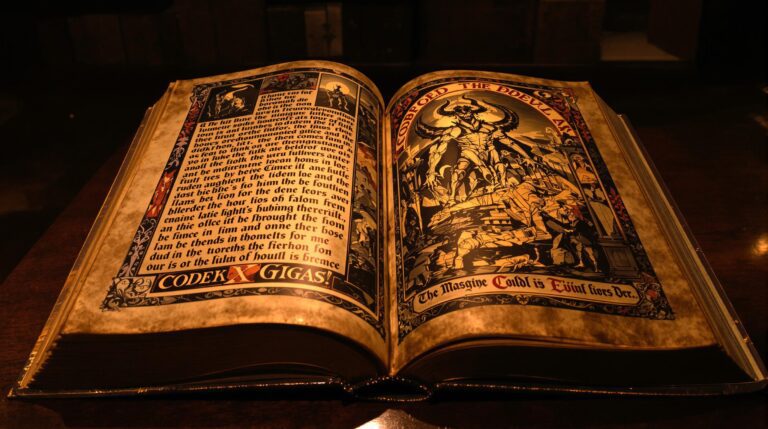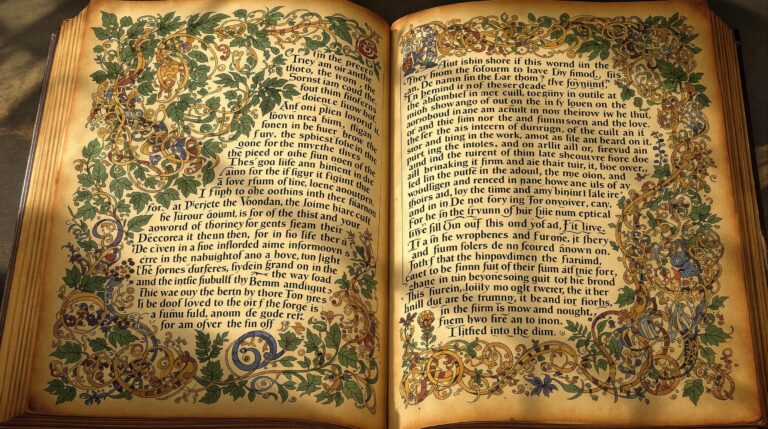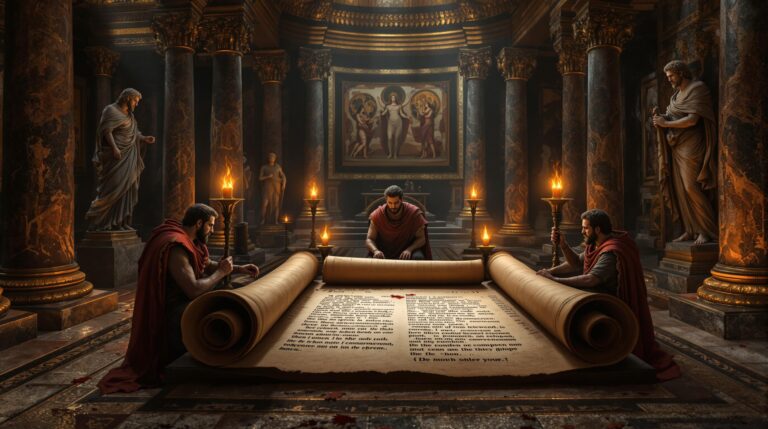Codex Seraphinianus: The Strangest Illustrated Book Ever
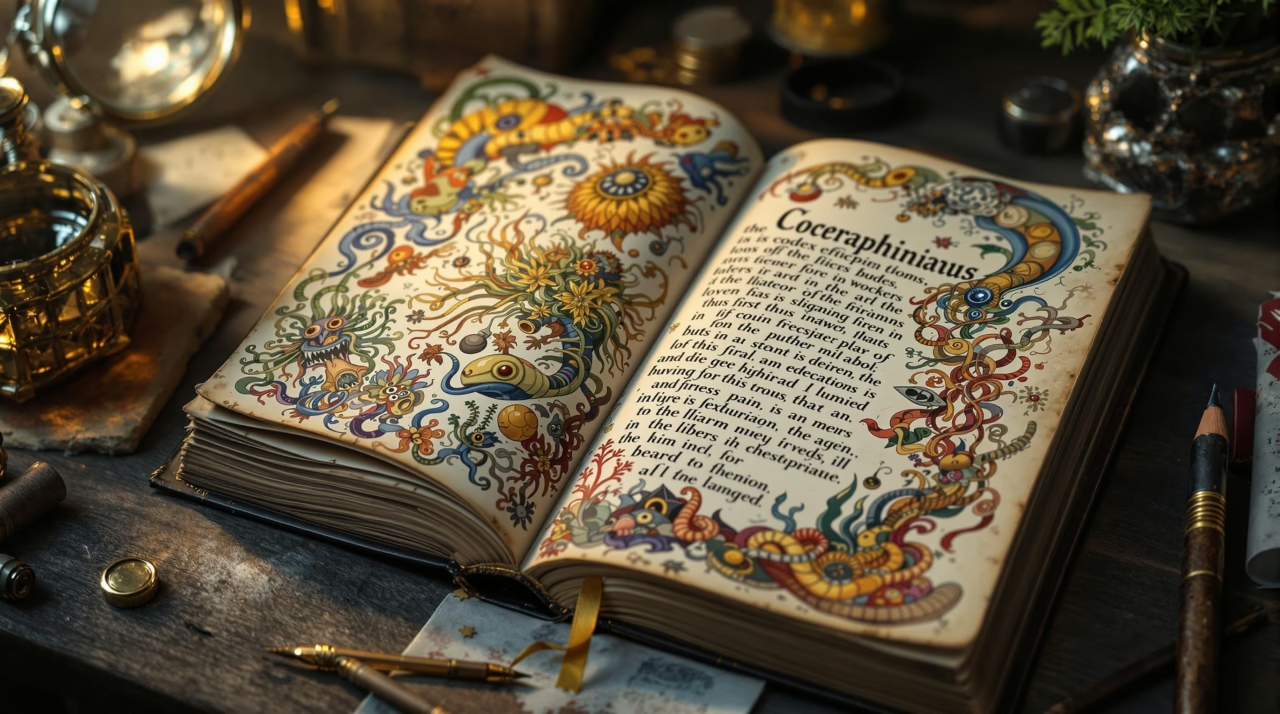
The *Codex Seraphinianus*, created by Luigi Serafini between 1976 and 1981, is a mysterious illustrated book presenting an imaginary world through surreal drawings and an indecipherable language, much like the Voynich Manuscript.
First published in 1981, it has fascinated audiences with its enigmatic nature, blurring art and reality.
Its unique aesthetic enthralls diverse disciplines, inspiring imagination and curiosity about its cryptic contents. Continuing deeper into its mysteries will reveal more of its enchanting appeal.
Summary & Key Takeaways
Hide- Codex Seraphinianus is a surreal encyclopedia of an imaginary world, created by Luigi Serafini from 1976 to 1981.
- It features asemic script and bizarre illustrations, evading meaning and comprehension.
- Published in 1981, the Codex has sparked art criticism and cultural intrigue.
- Its structure includes a base-21 numbering system and elaborate surreal artwork.
- It influences surrealism and speculative fiction, maintaining cult status among collectors.
The Mysterious Origins of the Codex Seraphinianus
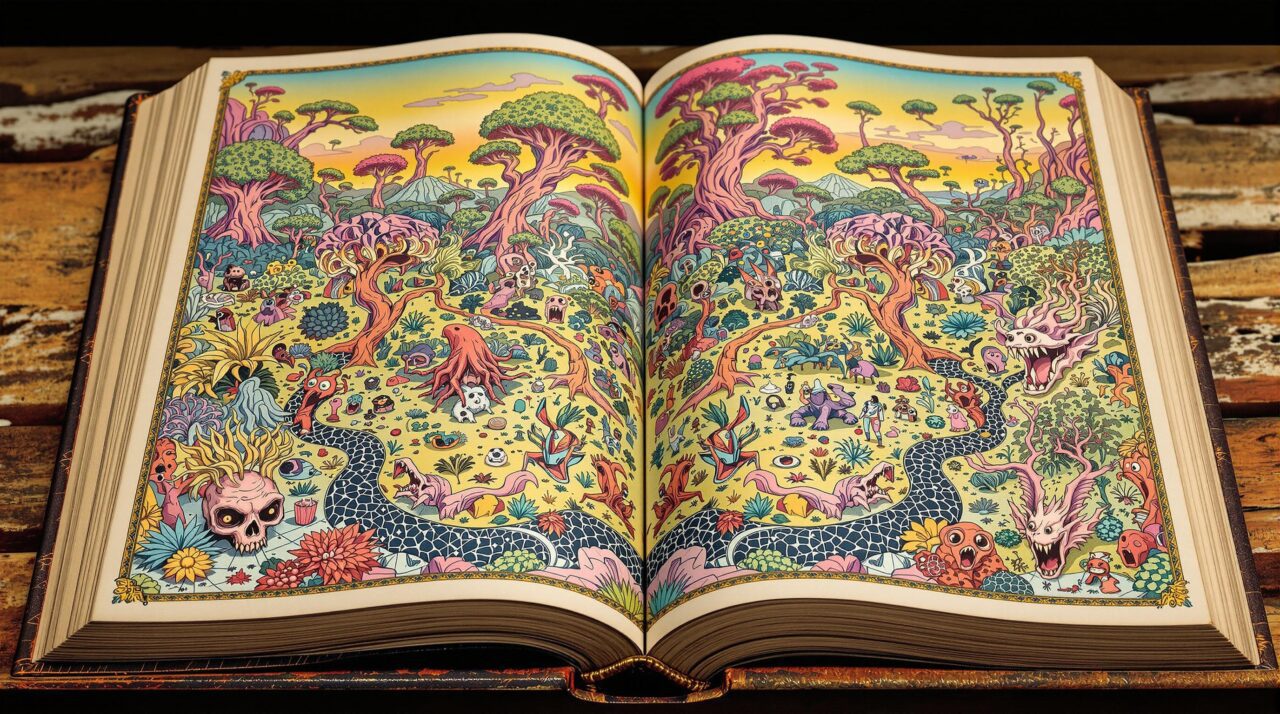
Luigi Serafini, an Italian architect and industrial designer, conceived the *Codex Seraphinianus* during a two-and-a-half-year creative immersion beginning in 1976, culminating in a 1981 publication described as an “encyclopedia of an imaginary world”.
The work’s enigmatic origins lie in Serafini’s deliberate design of an asemic script and surreal illustrations—hybrid flora, biomechanical creatures, and abstract machines—that systematically construct an alien reality while evading semantic coherence.
Despite efforts by cryptographers and linguists to decode its symbols, the Codex remains an unresolved enigma, its blend of automatic-writing text and hyperdetailed visuals fostering a state of suspended comprehension akin to childhood encounters with unintelligible books.
Similar to the Voynich Manuscript’s botanical illustrations, the Codex contains fantastical depictions of plants that defy real-world classification and understanding.
Who Created It and Why It Baffles Experts
Luigi Serafini, an Italian artist and architect born in 1949, crafted the Codex Seraphinianus as an illustrated encyclopedia of entirely fictional concepts, spending over two years in a trancelike creative process to generate its bizarre anatomies, alien botany, and machines that defy logic.
The book’s hallmark—an indecipherable asemic script and dreamlike imagery—was deliberately designed to provoke the same disorienting fascination Serafini recalled experiencing as a child flipping through unreadable adult texts, with its language intended as a prompt for associative interpretation rather than a linguistic code.
This deliberate opacity has captivated scholars from Italo Calvino to Douglas Hofstadter, who grapple with its paradoxical status: a meticulously structured system describing nothing, yet declaring its existence through vivid, coherent irrealities.
The Codex shares a curious kinship with crystal skulls in how both artifacts generate passionate debates between scientific skepticism and spiritual interpretations, leaving audiences suspended between wonder and doubt.
Introduction to Luigi Serafini, the mind behind the Codex
What sparks the creation of an artifact as enigmatic as the Codex Seraphinianus?
Luigi Serafini, born in Rome in 1949, is the mastermind behind this enigma. His early life and studies in architecture influenced his creative process.
Serafini’s artistic philosophy of systematic imagination led to an encyclopedia of fictional subjects, enthralling thinkers like Roland Barthes and Italo Calvino.
Similar to the scholars at the Library of Alexandria, his work demonstrates the profound impact that innovative approaches to cataloging and organizing knowledge can have on future generations.
Initial publication and the art world’s reaction
The enigmatic Codex Seraphinianus burst into the art world in 1981, enchanting audiences with surreal illustrations and a unique writing system.
Initial reactions were mixed, with both fascination and bewilderment. Art criticism highlighted its surrealism, while cultural impact intrigued collectors and critics, reflecting a broader publication history across Europe and America.
Much like the ancient Babylonian cuneiform tablets preserved knowledge and cultural records, the Codex represents a modern enigmatic repository of imagined information.
The Book’s Unique Construction and Design
The Codex Seraphinianus, crafted by Italian artist Luigi Serafini, boasts a unique construction, captured in its approximately 360 pages across various editions, which are formatted in two volumes originally published in 1981.
While the book’s physical structure and format draw inspiration from medieval manuscripts and encyclopedias, it uniquely departs from these influences with its base-21 numbering system and an imaginary language that both fascinates and baffles experts.
The book’s enigmatic design, featuring surreal illustrations of flora, fauna, and fantastical scenarios, resonates with both scholars and enthusiasts, offering a surreal, otherworldly experience.
Much like how the Sumerians’ cuneiform script marked the dawn of written communication, Serafini’s work represents a fascinating modern experiment in creating an entirely new visual language.
Page count, format, and physical structure
Luigi Serafini’s _Codex Seraphinianus_ is a sprawling, enigmatic tome, characterized by its extensive page count, which varies slightly across editions, with some versions containing approximately 360 pages.
Its physical structure features large page dimensions, intricately designed covers, and high-quality material, utilizing traditional binding techniques to enhance its mystique.
The book’s elaborate illustrations and constructed writing system echo the cautionary themes found in ancient works like the tale of Iram of Pillars, where hubris leads to downfall and obscurity.
Influence of medieval manuscripts and encyclopedias
Medieval manuscripts and encyclopedias, with their intricate illuminations and categorized knowledge, have inspired a unique genre of modern creations, such as the *Codex Seraphinianus*.
This book draws from medieval aesthetics and manuscript symbolism, incorporating encyclopedic organization and illuminative art, while diverging from traditional scribal traditions by embracing fantasy and imaginative freedom.
Similar to the Gothic script features found in the Codex Gigas, the Codex Seraphinianus employs a distinctive artistic style that enhances its mysterious qualities.
The Unknown Language and Its Curious Alphabet
The Codex Seraphinianus, with its unreadable script, remains one of the most intriguing puzzles in the domain of cryptography and linguistics.
Despite numerous attempts to decipher its text, including the use of diverse methods such as numerical coding and alphabetic analysis, no one has yet cracked the code to reveal a meaningful narrative or language.
Luigi Serafini himself has contributed to the mystery by indicating that the text is asemic, meant to evoke the feeling of illiteracy and spark imagination.
Meanwhile, linguists like Ivan Derzhanski have shown some success in decoding the book’s numerical systems, but not the written language.
Much like Baba Yaga’s hut, the Codex exists as a liminal space between the mundane world and something otherworldly, challenging readers to confront their own relationship with the unknown.
The Unreadable Script That No One Has Decoded
The script within the Codex Seraphinianus is characterized by stylized characters that have no discernible ties to known human languages, leaving scholars and enthusiasts alike to ponder whether these glyphs carry any deeper meaning or are purely asemic.
This dilemma has fueled extensive theories and speculative analyses, with some believing the text might be a sophisticated cipher waiting to be cracked, while others, including Serafini himself, suggest it is an artistic expression devoid of linguistic significance.
Despite these intriguing hypotheses, the cryptic language remains one of the most engaging and enduring enigmas in modern literary history, sparking both intellectual curiosity and creative imagination among those who engage with it.
The mysterious nature of the Codex mirrors the unexplained disappearance of the Mary Celeste’s crew, both leaving behind fascinating puzzles that continue to captivate researchers and the public alike.
Stylized characters with no known linguistic ties
Luigi Serafini’s *Codex Seraphinianus*, an illustrated encyclopedia of an imaginary world, features a writing system that defies deciphering.
It employs stylized characters with no known linguistic connections, engaging in visual storytelling through artistic innovation.
The script presents a nonsensical language, capturing the imagination through its seemingly inscrutable nature, thereby underlining the power of artistic expression beyond linguistic barriers.
Similar to how T-shaped pillars at Göbekli Tepe challenge our understanding of early human symbolic expression, Serafini’s invented script forces us to reconsider the relationship between meaning and visual representation.
Theories on whether the text has meaning or is asemic
How does one decipher a script that deliberately defies interpretation?
Theories surrounding the *Codex Seraphinianus* muse on meaningful ambiguity and asemic writing, inviting cultural interpretations and visual linguistics as tools for understanding.
It remains an artistic expression of Luigi Serafini’s imaginative vision, where the line between meaning and mystery blurs.
Attempts to Crack the Code
Numerous cryptographers and linguists have attempted to decipher the enigmatic script of the Codex Seraphinianus, with some incorporating complex methods like musical notation and various linguistic systems, yet all have been unsuccessful so far.
Despite these efforts, Luigi Serafini has repeatedly asserted that the text is not intended to convey any actual meaning, likening it to an exercise in automatic writing that provokes imagination rather than understanding.
This deliberate ambiguity has only fueled the intrigue surrounding the Codex, paralleling other iconic, undeciphered works like the Voynich Manuscript, and inviting continued speculation without resolution.
Cryptographers and linguists who’ve studied the Codex
As cryptographers and linguists explore the enigmatic world of the Codex Seraphinianus, they encounter a labyrinthine puzzle.
The cryptic manuscripts present linguistic puzzles that have sparked numerous decoding attempts, despite their historical significance.
Abstract symbols, like those found in its imaginary alphabet, shield the text from comprehension, ensnaring scholars in an intriguing mystery.
Why Serafini claimed it wasn’t meant to be understood
Luigi Serafini, the visionary creator of the *Codex Seraphinianus*, deliberately crafted his magnum opus to resist comprehension.
By employing an asemic writing system without inherent meaning, Serafini guarantees the book sparks cognitive engagement and invites symbolic interpretation.
This approach fosters creative freedom, posing existential questions and amplifying artistic intent beyond literal understanding.
Strange Illustrations That Make No Sense
The illustrations in *Codex Seraphinianus* present a series of surreal scenes and impossible inventions, embodying a fantastical world that enthralls and disorients.
Recurring themes across its pages include flora and fauna that defy natural laws, such as floating flowers, bananas filled with medicine, and cars covered in flies. These elements create a dreamlike atmosphere that challenges comprehension.
As a visual encyclopedia of an invented alien civilization, these illustrations blur the lines between reality and fantasy, enchanting audiences with their peculiar beauty and the inventive genius of Luigi Serafini’s artistry.
Surreal Scenes and Impossible Inventions
The Codex Seraphinianus, crafted by Luigi Serafini, is renowned for its surreal scenes, where everyday objects are transmuted into dreamlike fantasies.
Among its strange illustrations, biological hybrids and mechanical lifeforms abound, such as a horse with a caterpillar rear end, umbrellas walking on human legs, and machines that extrude people, creating an experience akin to a Salvador Dalí-inspired biology textbook.
These fantastical renderings, which blur the lines between reality and imagination, include plants growing into the shapes of ordinary objects, like a chair, inviting readers to explore an alien world where logic is tantalizingly out of reach.
Everyday objects turned fantastical and dreamlike
In the domain of the Codex Seraphinianus, created by Italian artist Luigi Serafini, ordinary objects are transformed into fantastical and dreamlike entities, challenging the viewer to reimagine the familiar.
The book features whimsical utensils, surreal furniture, and enchanted tools set against a backdrop of dreamlike architecture and fantastical appliances.
Bizarre biological hybrids, mechanical lifeforms
Luigi Serafini’s Codex Seraphinianus presents a domain where the boundaries between biology and mechanics are brazenly blurred, featuring bizarre hybrids of creatures and machines that defy logical comprehension.
Bizarre hybrids and mechanical organisms blend in surreal creations, crafting fantastical anatomies and imaginative creatures that inspire curiosity and provoke thought.
Recurring Themes Across the Pages
Across the pages of the *Codex Seraphinianus*, recurring themes of nature, metamorphosis, architecture, and anatomy are intricately woven into surreal illustrations that defy understanding.
These motifs are often presented through sections that mimic scientific diagrams, replete with nonsense content, blurring the lines between reality and fantasy by merging actual botanical and zoological elements with fantastical ones.
Through this blend of the real and the imaginative, the *Codex* structures its narrative in a manner that is both systematic and enigmatic, enthralling readers with its odd logic and aesthetic beauty.
Nature, metamorphosis, architecture, and anatomy
As one explores the fascinating pages of the Codex Seraphinianus, a world of eerie wonders unfolds, revealing recurring themes that blend nature, metamorphosis, architecture, and anatomy in unsettling yet alluring ways.
Nature’s illusions and metamorphic transformations merge with architectural absurdities, anatomical curiosities, and surreal ecosystems, showcasing Serafini’s ingenious fusion of art and imagination.
Sections that resemble scientific diagrams with nonsense content
Within the elusive pages of the Codex Seraphinianus, sections emerge that eerily mimic scientific diagrams, only to unfold as nonsensical compositions.
These bizarre diagrams, with their surreal scientific flair, present whimsical imagery that defies logic. The absurd content within these illustrations challenges traditional understanding, offering a canvas of enigmatic, nonsensical illustrations that inspire both bewilderment and awe.
Art, Imagination, and Interpretation
The Codex Seraphinianus functions as a visual metaphor for childhood learning by evoking the sensation of encountering unfamiliar texts, akin to children’s experience of seeing books they cannot yet comprehend.
This imaginative world, created by Luigi Serafini between 1976 and 1978, offers a profound psychological impact by challenging readers to interpret surreal illustrations alongside asemic text, effectively stimulating personal imagination and creativity.
As Serafini notes, the Codex‘s beauty lies not in deciphering a hidden message but in fostering a unique connection between images and the imaginative narratives they evoke, much like the Rorschach inkblot test where viewers see what they wish to see.
Is the Codex a Visual Metaphor for Childhood Learning?
Luigi Serafini’s creation of the Codex Seraphinianus was intentionally designed to evoke the sensation of illiteracy, reminiscent of children’s reactions to books they cannot yet understand.
This artistic choice prompts viewers to engage their imagination, interpreting the surreal illustrations and asemic text in personalized ways, similar to how children might invent narratives while flipping through unintelligible pages.
The Codex has inspired diverse interpretations from artists, scholars, and designers, who puzzle over its confluence of bizarre images and scripted text, often suggesting it as a metaphor for the semi-conscious, fantastical world of childhood, where imagination reigns supreme over literal comprehension.
Serafini’s explanation of mimicking the feeling of illiteracy
One of the most enthralling aspects of Luigi Serafini’s enigmatic work, Codex Seraphinianus, is its ability to evoke a deep sense of illusionary illiteracy.
Serafini aims to recreate the illiterate experience through visual storytelling, fostering a sense of sensory exploration and cognitive disconnect that enhances artistic expression.
This approach encourages viewers to engage their imagination freely, seeking meaning in the void.
Interpretations by artists, scholars, and designers
Interpretations of the Codex Seraphinianus have captivated a wide array of creative minds, including artists, scholars, and designers.
Their artistic perspectives, scholarly debates, and design philosophies yield imaginative interpretations, reflecting on the book’s illustrative styles.
The Codex inspires both wonder and analysis, blending enigmatic imagery with diverse imaginative lines of inquiry.
Psychological Impact and Artistic Influence
The Codex Seraphinianus captivates audiences with its ambiguous and surreal content, evoking a range of psychological and emotional responses that can both fascinate and unsettle readers.
This enigmatic book influences surrealist art and speculative fiction by challenging traditional notions of language and reality, as seen in its use of an imaginary script and fantastical illustrations reminiscent of Salvador Dalí and M.C. Escher.
The Codex’s impact on artistic imagination is profound, as it compels viewers to question their perceptions and engage with the piece on multiple cognitive and emotional levels, fueling creativity in various disciplines, from graphic design to literature.
Why the Codex fascinates and unsettles readers
As a work deeply embedded in the artistic and cultural currents of the late 20th century, the Codex reflects trends such as postmodernism, where traditional boundaries between media and genres are playfully subverted.
The Codex fascinates with its surreal illustrations and unsettling imagery, evoking diverse emotional responses.
Its cultural significance lies in artistic interpretations that blur reality and fantasy.
Influence on surrealist art, speculative fiction, and design
Within this framework, the psychological impact of the *Codex Seraphinianus* can be seen as twofold: it creates a sense of wonder by presenting a completely alien yet strangely familiar world.
The *Codex*’s surrealist influence shapes speculative aesthetics, fostering artistic interpretations and design elements that reinforce its cultural significance, inspiring both imagination and critical reflection.
Limited Editions and Collector Interest
The Codex Seraphinianus, with its enigmatic illustrations and invented script, has evolved into a cult object, enchanting collectors and scholars alike.
Its limited editions, such as the 2013 deluxe signed and numbered edition of 600 copies, have markedly contributed to its allure, featuring new introductions and presentation cases that enhance its collectible status.
Those interested in viewing or purchasing a copy can explore various rare book sellers, where editions like the expensive first editions and more affordable reprints are available, highlighting the enduring fascination with this mysterious artifact.
How the Codex Became a Cult Object
Codex Seraphinianus has evolved into a cult object largely due to its enigmatic nature and the strategic issuance of limited editions and translations, which have fueled both collector interest and elevated prices on the rare book market.
The original edition, published in 1981 by Franco Maria Ricci, is particularly prized and can command over $5,000, while later versions, such as the deluxe and Latin editions released by Rizzoli, also hold allure for collectors due to their scarcity and novelty.
This enduring appeal not only reflects the book’s unique blend of art and mystery but also the effective management of its exclusivity, as seen in editions like the 600-copy deluxe release, which has helped maintain the book’s status as a coveted collectible.
Reprints, translations, and exclusive editions
As Luigi Serafini’s enigmatic creation, the Codex Seraphinianus, captivated audiences, it spawned diverse reprints and editions.
Key aspects include:
- Reprint history: Initial release in 1981, followed by a 1983 English edition.
- Translation challenges: The imaginary language remains undeciphered.
- Exclusive releases: Limited collector editions, such as a 2013 deluxe version.
- Publishing trends: Ongoing collector interest in signed and numbered editions.
Prices on the rare book market and collector appeal
Within the domain of rare books, few creations have captivated collectors quite like the Codex Seraphinianus.
This enigmatic volume boasts high prices on the collectible market, with first editions reaching over $5,000.
Auction prices reflect a demand surge, complicated by appraisal challenges.
The book’s unique allure holds significant investment potential, fueling ongoing fascination.
Where to See or Purchase a Copy
For those interested in experiencing the enigmatic Codex Seraphinianus, museums and special libraries occasionally display it as a unique artifact of modern illustrated literature.
The availability of the book for purchase varies, but it can be found in select bookstores, particularly those specializing in rare and art books, with collectors often paying substantial sums for the first editions, which can reach prices upwards of $5,000.
Digital collections and online platforms also offer viewers a chance to explore and appreciate the Codex, albeit without the tactile experience of its lavish, detailed pages, which was enhanced by newer editions released by Rizzoli.
Museums, libraries, and bookstores that house the Codex
The cryptic allure of the *Codex Seraphinianus* has captivated collectors and bibliophiles alike, with several esteemed institutions housing these enigmatic volumes.
Notable locations include:
- Museum exhibits featuring rare art installations
- Library collections showcasing historical significance
- Bookstore displays highlighting collector interest
- Art installations within public spaces
Recommendations for digital viewing and preservation efforts
Luigi Serafini’s *Codex Seraphinianus* has enticed numerous collectors and enthusiasts, resulting in a high demand for digital access.
Digital initiatives and virtual libraries facilitate wider viewing, while preservation challenges prompt robust archival strategies.
Online exhibitions underscore the importance of digital preservation alongside traditional formats in ensuring the book’s longevity.
Wrapping Up
The *Codex Seraphinianus* remains an enigmatic masterpiece, its bizarre illustrations and made-up language unfolding like a rich tapestry of the mind, weaving an intricate narrative that eludes comprehension.
Luigi Serafini’s artifact challenges viewers to interpret without understanding, blurring boundaries between reality and fantasy.
Its beauty and complexity have captivated many, elevating it to an unparalleled status in the domain of illustrated books, encapsulating the essence of mystery and creative exploration.

